 It’s always wonderful to see an artist’s finished work, but rarely do you get a chance to see their creative process. Especially when that process includes a correspondence with Toni Morrison! In researching the Toni Morrison Papers for our current exhibit, we were delighted to discover the charming and captivating work of artist Pascal Lemaître. From sending Morrison quick sketches in the margins of a fax, to a funny observation in a letter, to a touching dedication on a card, Lemaître’s warmth, playfulness, and vibrancy shone out of every folder and archive box we opened.
It’s always wonderful to see an artist’s finished work, but rarely do you get a chance to see their creative process. Especially when that process includes a correspondence with Toni Morrison! In researching the Toni Morrison Papers for our current exhibit, we were delighted to discover the charming and captivating work of artist Pascal Lemaître. From sending Morrison quick sketches in the margins of a fax, to a funny observation in a letter, to a touching dedication on a card, Lemaître’s warmth, playfulness, and vibrancy shone out of every folder and archive box we opened.
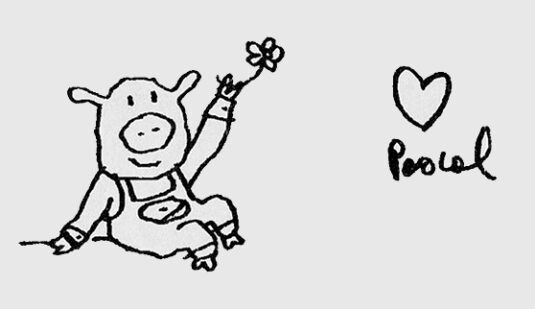
Original illustration of pig holding a flower by Pascal Lemaître; Toni Morrison Papers, Manuscripts Division, Department of Special Collections, Princeton University Library.
Based in Belgium, Lemaître is a freelance author and illustrator with an impressive catalog of publications for both children and adults. His work has appeared in The New Yorker, The New York Times, Le Monde, Libération, Le 1, Lacroix, Astrapi, J’aime Lire, Pom d’Api and Dorémi. In early 2000, he began working with Toni and Slade Morrison on their second children’s book, The Book of Mean People, and continued that collaboration with three subsequent stories: The Ant or the Grasshopper, The Lion or the Mouse, and Poppy or the Snake, which are all part of the innovative Who’s Got Game series.
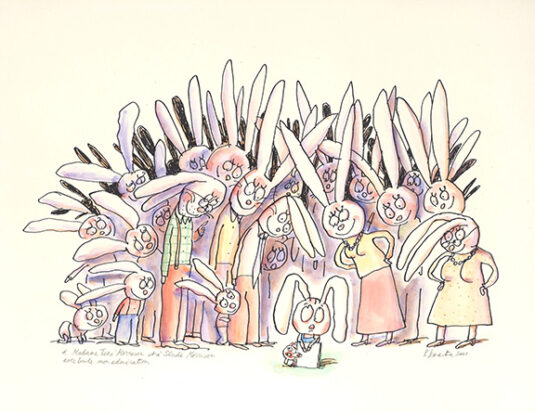
The Book of Mean People original Illustration with inscription by Pascal Lemaître; Toni Morrison Papers, Manuscripts Division, Department of Special Collections, Princeton University Library.
I reached out to Lemaître to ask about his artistic process and experience in working with Toni and Slade Morrison. The interview was conducted in French and is translated below. The original French version can be found here.
How did you first meet the Morrisons?
In the office of Carolyn Reidy, president of Simon & Schuster. We had a meeting about the Who’s Got Game series, for which I had received the initial text draft. I had sent a proposal for a comic book adaptation with a range of dominant colors depending on the album and the place where the story took place. Madame Morrison had my envelope in her hand. She and Slade were excited. Madame Morrison had read comics in her youth and was partial to this medium and she gave me carte blanche. I was with my agent, writer Holly McGhee. Nan Graham and Alexis Gargagliano managed the project for Scribner.
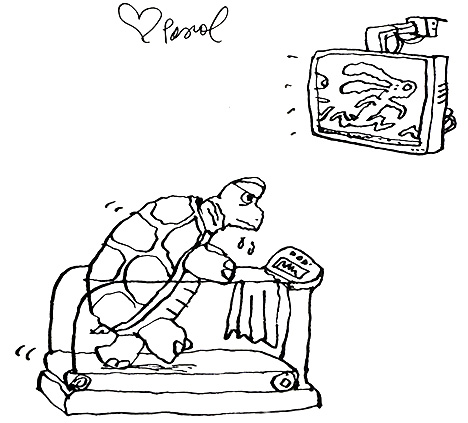
Original illustration of turtle by Pascal Lemaître; Toni Morrison Papers, Manuscripts Division, Department of Special Collections, Princeton University Library
Before we start talking about Toni & Slade’s books, had you ever illustrated for children before?
Yes, my first book was published in 1992 by Editions du Seuil and translated into English by Hyperion in 1993. But I had mainly worked in children’s publishing in Belgium and France, a lot for Bayard Presse which publishes magazines such as Astrapi, J’aime Lire, Pom d’Api etc. Some of my drawings had already been published in The New Yorker.
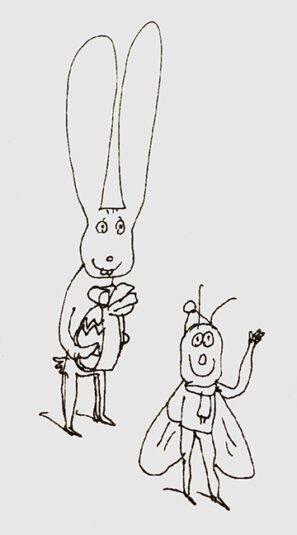
Original illustration of rabbit and bug by Pascal Lemaître; Toni Morrison Papers, Manuscripts Division, Department of Special Collections, Princeton University Library
Can you tell us a bit about your creative and collaborative process with them?
For The Book of Mean People, my sketches went through Andrea Pinkney, editor at Hyperion. For the Who’s Got Game series, I spoke directly with Madame Morrison. She was very welcoming, open and warm. It helped me to feel free and to forget that she was a Nobel Prize winner. Slade, being a painter and a musician, also respected and encouraged my freedom. It was he who told his mother how much the morality of Aesop’s fables bothered him. I submitted my graphic-designed sketches of the characters and made adjustments according to their requests. I then moved onto dividing the stories into boxes with the speech bubbles which were reread and sometimes adjusted by Madame Morrison so that there was not too much redundancy between the content of the image and the text.
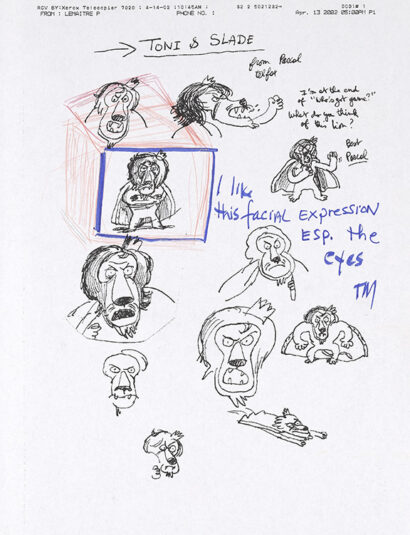
Various lion sketches by Pascal Lemaître with notes from Toni Morrison; Toni Morrison Papers, Manuscripts Division, Department of Special Collections, Princeton University Library
For The Ant or The Grasshopper the text’s lyricism made me think of poetry slams and hip-hop. So I set the action in Brooklyn with gray-blue tones that convey the chill of autumn and winter. For The Lion or the Mouse, there were passages of inner thought that made me think of Kurosawa films like “Ran,” when the clan leaders start monologues. The rhythm of comics offers these possibilities of slowness. The Lion or the Mouse has dominant warm colors and takes place in Africa.
Poppy or the Snake is the only book where Madame Morrison asked me to draw black characters. I proposed that the action take place in Louisiana and to have the book in swampy green tones to continue this idea of books differentiated by their color atmospheres. I drew a 1950s Dodge pickup for aesthetic reasons. I photographed it at a Belgian collector of American cars. He has a big hangar with lots of old American cars. It was the Belgian cartoonist Evermeulen who introduced him to me. For Poppy, I made a small sculpture of his face to draw from different angles.

Image courtesy of Pascal Lemaître.
I knew Louisiana from having stayed there. I was able to add symbols like dogs (inhabited by the souls of the dead) and make reference to the Blues by introducing a moment when Poppy meets a singer (Robert Johnson) while going shopping.This story within the story was a homage to Slade’s relationship to music and connected with the musical grasshopper of the previous volume.
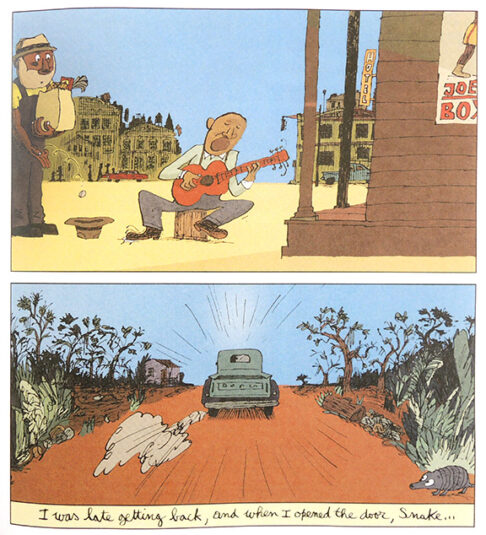
Who’s Got Game? Poppy or the Snake? Simon & Schuster, 2003
We did proof readings with Toni Morrison in her Center Street apartment. She was a joy to listen to. She spoke with such pleasure. She was extremely quick-witted and lively. She was very tolerant and patient with me given my very average English. Luckily for me, she loved Edith Piaf. P.s. – there is another story that was illustrated, but not published.
I’m curious – the title The Book of Mean People makes me think the “bad guys” would be humans, but the characters are actually rabbits. Has there been a lot of discussion about this?
At my level, no. However, I do not know if there was any between the publisher and Madame Morrison. I had received a rather short draft by fax in Brussels. To have a book of a minimum of 24 pages, I proposed making a double page per line. Additionally, this text seemed universal to me. It was about the gap between adults and children as well as a relationship to language (I will come back to this later). It is for this reason that I created animal characters, to avoid having to stereotype humans. Also, the rabbits allowed me to bring a softness to this rather hard text and to play more free and symbolic games with the ears, for example. The rabbits also allowed the final image to be a return to nature, to the forest. I think this idea of a story within a story interested Madame Morrison and opened the door for me to collaborate on the Who’s Got Game series.
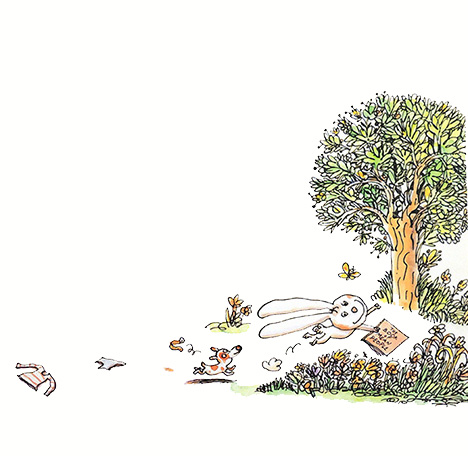
The Book of Mean People, Hyperion Books for Children, 2002.
A few years ago I proposed to do an illustrated French version of her Nobel Prize speech. This text is very strong and addresses the vulnerability of language just like in The Book of Mean People where the words also lend themselves to confusion and misunderstanding. Entre vos mains [“In Your Hands”] was published in 2018 by Editions de L’Aube.
Is there an illustration from your children’s book collaborations with the Morrisons that is really meaningful to you? And why?
I think it’s the grasshopper in the cardboard box in the middle of Central Park. I feel like text and image work well. The picture is so sad. It is also a reference to Charlot (a.k.a. Charlie Chaplin) poor and alone in the silence of the night and in silent cinema. Madame Morrison’s idea of crumbling wings is such a strong one.
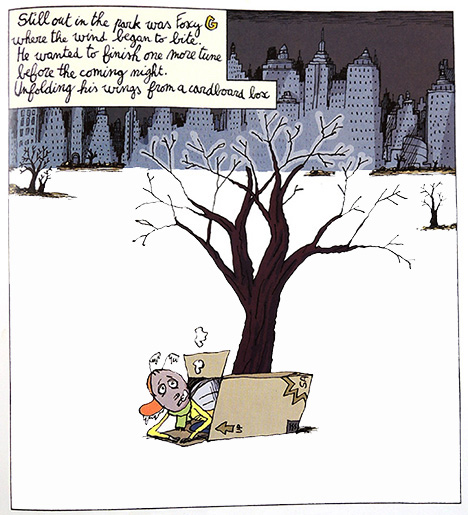
Who’s got Game? The Ant or the Grasshopper? Scribner, 2003.
Toni Morrison is so amazing, what impact has working with her had on you as an artist?
I would define “extraordinary” in the sense of extra-ordinary, out of the ordinary. She is one of those people who are living proof that life can be vast, who broaden the horizon of thought and of humanity. I would also add this line from Guillaume Apollinaire that my friend Stéphane Hessel adored and which reminds me of her: “We want to explore the enormous kindness of the land where everything is silent.” Collaborating with Madame Morrison was so motivating, so nourishing. I had the feeling of being useful to a cause. It was a huge acknowledgement. It gave me self-confidence without forgetting the fragility of existence and of the world. It was also an apprenticeship with a heroine of history. It was something! I had a lot of affection for Slade and her. Slade was touching and very sensitive. But I’ll stop writing there because I am tearing up. We have lost the Sun.
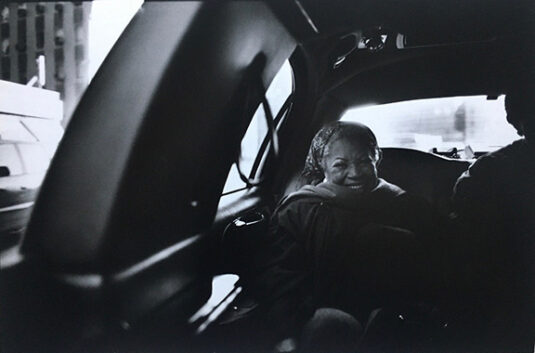
Image courtesy of Pascal Lemaître.
In our archives, a ladybug walking a smaller bug appears several times in your sketches and correspondence. We see a final version of her on the first panel of The Ant or the Grasshopper Does this character have a special meaning for you? We have our theories…
I’m curious to find out your theory. This character is also effectively a story within the story.
My theory is that it is a tribute to an important woman that you hold in high affection in your life. Did I get close?
You got it ;)
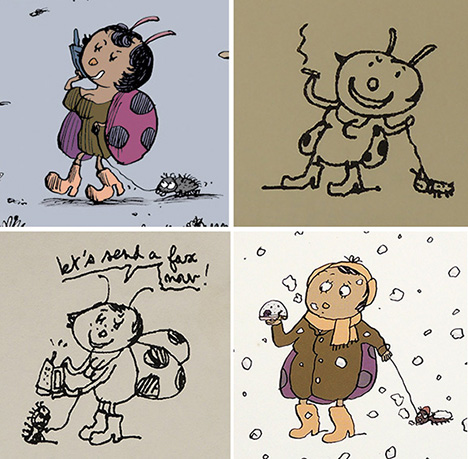
Illustrations (two original) of ladybugs by Pascal Lemaître; Toni Morrison Papers, Manuscripts Division, Department of Special Collections, Princeton University Library
Thank you for interviewing today, it was truly an honor and a privilege! Is there anything you would like to add?
I would like to thank Ford Morrison and express my gratitude for their support.
Many thanks to Mireille Djenno, Global Special Collections Librarian, for her translation work. We appreciate it!
